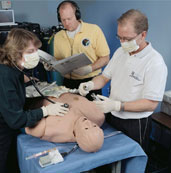HOUSTON – A lifelike mannequin will be teaching astronauts, flight surgeons and other mission personnel how to effectively manage medical emergencies in space.
"This patient simulator is no dummy. It breathes, has a heartbeat, pupils that react to light and medications, a pulse that can be felt at five locations, and lung sounds," said Dr. Hal Doerr, head of the Medical Operational Support Team, a joint project of the National Space Biomedical Research Institute (NSBRI), NASA Johnson Space Center and its support contractor, Wyle Laboratories. "About 200 parameters can be changed, so we can create any type of patient and then simulate medical events that could happen."
As mission lengths grow, the possibilities for medical problems in space increase. To expand the training of crew medical officers, NASA tasked the NSBRI with designing realistic training scenarios for astronauts and ground personnel involved in mission operations.
"This simulator will give us an extremely realistic setting to validate and integrate medical procedures and medical equipment," said Dr. Jim Logan, MOST project administrator from NASA’s Medical Informatics and Health Care Systems Office. "The project also links the medical and operations sides of a mission. In the event of a medical emergency, all parts of the mission team – crew, flight surgeons, biomedical engineers and flight operations – need to be ready to react at a moment’s notice."
The patient simulator, developed by Medical Education Technologies Inc., is linked to a sophisticated computer, designed along the lines of a flight simulator, that controls the ‘patient’s’ reactions and can be programmed to mimic various situations that could occur.
For a session on allergic reactions to medications, participants will face a wheezing simulator with a rapid pulse and swollen tongue. In some scenarios, the simulator will be programmed to talk.
Doerr’s group is ensuring that the simulated patient represents a potential astronaut by gathering data on the current astronaut pool. Physiologic changes that occur in space as a mission progresses also are programmed into the computer, so that realistic space scenarios can be created.
"We’re developing programmed scenarios for possible emergencies, such as crush trauma, inhalation burn, allergic reactions, decompression sickness, eye injury, respiratory distress, or myocardial infarction," said Doerr, director of the Houston Center for Advanced Patient Simulation at Baylor College of Medicine. "Each scenario looks at how the injury or illness can be treated with the equipment on board and for how long."
NSBRI researchers, who study the health problems associated with long-term space flight, will participate in planning for the different medical contingencies. Once the scenarios are complete, Doerr says training will be most effective if it occurs in a room that mimics the size, look and sounds of areas available for medical care on the International Space Station.
"When teaching, you must be able to make the participants suspend disbelief. It is hard to think clearly in a medical emergency. We’re trying to create enough stress to make it realistic, so that they will fail," he said. "Once they see how difficult it can be, we explain why they failed, work through the problems and do it until they succeed."
Doerr, who trains anesthesiology residents and firefighters on simulators, says this type of training will give astronauts the tools to work through an emergency medical situation more effectively.
"The practice sessions teach critical thinking and critical communications. They learn how to communicate clearly to ground crews and each other during medical emergencies," Doerr said. "Crews will be prepared to provide the best in-flight medical care possible."
###
The NSBRI, funded by NASA, is a consortium of institutions studying the health risks related to long-duration space flight. The Institute’s 97 research and education projects take place at 75 institutions in 22 states involving 269 investigators.






